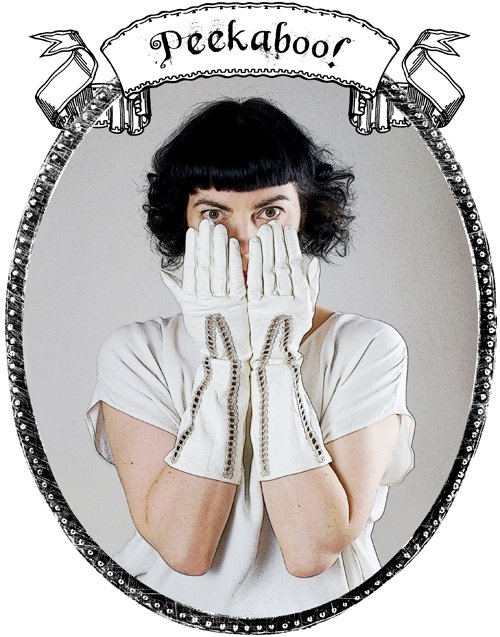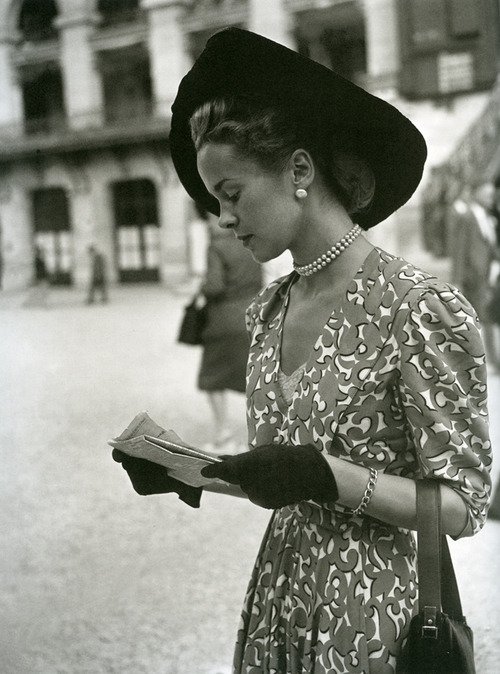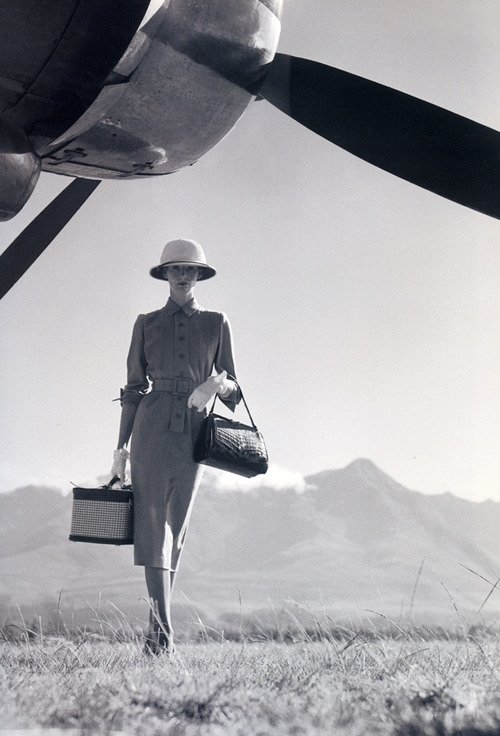The Politics of Accessories and Elegance
 Time was that to be truly fashionable, a lady’s accessories all had to match, and the materials they were made from had to be appropriate for the occasion and time of day. Happily, we no longer live in such restrictive times, and today looking matchy-matchy is a horrible insult, a death knell to any pretentions to style.
Time was that to be truly fashionable, a lady’s accessories all had to match, and the materials they were made from had to be appropriate for the occasion and time of day. Happily, we no longer live in such restrictive times, and today looking matchy-matchy is a horrible insult, a death knell to any pretentions to style.
Looking backwards to the hey-dey of matchy-matchiness, the 1940s and 50s, I can do no better than to quote Genevieve Anotine Dariaux, French style guru, once derectrice at Nina Ricci, and author of the famous book A Guide to Elegance, first published in 1964:
‘The accessories worn with an outfit – gloves, hat, shoes, and handbag – are among the most important elements of an elegant appearance. A modest dress or suit can triple its face value when it is worn with an elegant hat, bag, gloves, and shoes, while a designer’s original can lose much of its prestige if its accessories have been carelessly selected.’
Quite the opposite is true today, when every fashionista rich or poor mixes new with vintage, high with low, with seemingly at times a particular delight in clashing as much as possible.
 Elegant woman at Longchamp, Anonymous, 1947 (from ‘Parisiennes’, Flammarion 2007)
Elegant woman at Longchamp, Anonymous, 1947 (from ‘Parisiennes’, Flammarion 2007)
Seasonal Sets
Dariaux continues to elaborate on accessories, stating it is indispensable to own a complete set of accessories in black, and if possible, also brown plus beige shoes and a beige straw bag for summer. Ideally one would have every set suitable for sport, and the other dressy. Dariaux is filled with dismay when she sees a woman carrying an alligator handbag with a dressy ensemble, simply because she wishes to get good wear out of such an expensive item. (Has Dariaux not heard of the cost per wear equation?) ‘Alligator is strictly for sports or travel, shoes as well as bags, and this respected reptile should be permitted to retire every evening at 5pm.’
bright coloured shoes should only be worn under electric lights with a long or short evening dress
She has similar damning words for bright coloured shoes, which ‘should only be worn under electric lights with a long or short evening dress’.

All White is Not Alright
White shoes should never be seen on a city street – except for a tropical city, and even then only in summer, and only with a white dress. White handbags are impermissible except for the beach and summer resorts, but provincial in the city, even at the height of summer. Today fashion editors love to advocate white for winter, and I love it. Well truthfully, I love white anytime.
White handbags are impermissible except for the beach and summer resorts …
Gloves
But what does Dariaux say of gloves? They are best in neutral shades, and the most elegant of all are glacé kid. Suede and antelope are her second choices. Surprisingly, she gives good-quality thicker nylon gloves the thumbs-up.
She also believes gloves ought to be devoid of trimming, which I don’t at all agree with, while very long black gloves are the most elegant to wear with evening gowns. I own dozens of pairs in many colours and materials, even own a pair or two of crocheted lace and transparent nylon, which are both particularly despicable to Dariaux. Stylishly trimmed gloves I think are fun, and even an elegant woman can have fun sometimes!
 The entrance to the Paris Ritz on place Vendôme, Anonymous, c. 1948 (from ‘Parisiennes’, Flammarion 2007)
The entrance to the Paris Ritz on place Vendôme, Anonymous, c. 1948 (from ‘Parisiennes’, Flammarion 2007)
The Politics of Fashion and Elegance
Today of course most of us don’t wear any of our accessories in our day-to-day lives because they are ‘proper’ or traditional, but simply because we enjoy them. And of course the definition of elegance has changed slightly from Dariaux’s day when it was a stifling; it still means timeless chic in most lexicons, but there is a little more leeway for wit and daring, especially when it is employed with restraint.
In 1958, Claire McCardell, an American designer of the same era as Genevieve Dariaux, says:
‘Accessories are the signatures of your special tastes, clues to the type of woman you like being. Each is an idea in itself and you will quickly learn that you can’t wear too many ideas at the same time.’
This is permission to experiment a little more generous than that of Dariaux. The latter’s restrictive rules seem ludicrous to modern ears, but it wasn’t she who laid the law down: those fashion bills were passed with Christian Dior’s New Look in 1947, and the entire world imposed them on women who held any pretension to elegance, glamour – and worse than that: womanliness.
 Unpublished variant of a cover image for American Vogue, bu Erwen Blumenfeld, 1950
Unpublished variant of a cover image for American Vogue, bu Erwen Blumenfeld, 1950
Marnie Fogg, editor of Fashion: The Whole Story (Thames and Hudson, 2013) in the section ‘Daytime Decorum’ explains in a nutshell:
‘It was a perfect storm of events that resulted in the housewife of the 1950s becoming deified. Targeted by government policies, the fashion industry and advertisers, both she and her home were buffed, groomed and venerated. Liberated from the privations of wartime rationing, her clothing celebrated femininity with strict fashion discipline. A façade of perfection had to be upheld at all costs; to leave the house without a hat was little short of insurrection.’
 Alligator is correctly worn for travel or sport, according to Genevieve Dariaux. Wenda Rogerson, by Norman Parkinson, Vogue 1951Women’s liberation stalled after World War II, when American politicians advocated the return of women to their former role of homemakers so that homecoming servicemen would have jobs to return to. Instead, it was a woman’s job to be the perfect housewife. The social, moral and economic stability of the United States was entirely ‘dependent on men returning to their role as head of the household. Fashion played a significant role in this process by restoring the notion of traditional feminine clothing and making the business of dressing complex, with style diktats for every social and domestic function.’ [Ibid] It would take the next generation to change the world in the 1960s, when the fashion industry was turned on its head.
Alligator is correctly worn for travel or sport, according to Genevieve Dariaux. Wenda Rogerson, by Norman Parkinson, Vogue 1951Women’s liberation stalled after World War II, when American politicians advocated the return of women to their former role of homemakers so that homecoming servicemen would have jobs to return to. Instead, it was a woman’s job to be the perfect housewife. The social, moral and economic stability of the United States was entirely ‘dependent on men returning to their role as head of the household. Fashion played a significant role in this process by restoring the notion of traditional feminine clothing and making the business of dressing complex, with style diktats for every social and domestic function.’ [Ibid] It would take the next generation to change the world in the 1960s, when the fashion industry was turned on its head.

Matching v. Monochromatic
While I feel quite passé if my accessories match too well, I do think it fun to wear an entirely monochromatic outfit, especially all white. Black is my only exception for I find it dreary if it is not leavened with at least one other neutral. Kim Kardashian as we all know is very fond of wearing all beige, but I think it’s just because she likes that it makes her look naked.
Monochromatic outfits can be quite startling and eye-catching when one has become accustomed to the current popular trend for mismatching, which, with the encouragement of the fashion industry, many positively gorge on and glory in. Clash your prints! Mix and match! These are the clarion cries of this movement, and so often it is not done sympathetically. Wearing all one colour can in fact be soothing to the eye for just that reason.
I do not dispute that there were beautiful fashions in the post-war era, but today we have many more options than such rigorous and stifling rules and regulations. We can have fun, experiment – matchy-matchy or not according to personal preference – for even if we do commit some grave sartorial error we can take heart: the Fashion Police still can’t put us in jail for insurrection.
Photos: April 2016

